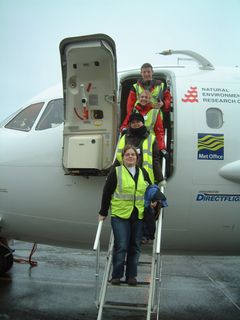

|
|
|||
|
|
|||
|
|
|||
|
|
|||
|
|
|||
|
|
|||
|
|
|||
|
|
|||
 |
|||
Saturday 10th - Last Mission Of The Campaign |
The last mission of the campaign turned out to be a double, perhaps triple, target mission. Firstly, the ETKF were showing significant sensitivity to the southwest of Greenland, for both verification regions, in relations to a synoptic cyclone that was predicted to deepen as it moved quickly to the northwest. We were expecting to feel it's power Saturday evening and at least parts of Sunday. Secondly, the high resolution MM5 forecast for Iceland was showing wave breaking over the highest mountain in Iceland, Hvannadalshnjúkur, at the southern edge of Vatnajökull. The plan was therefore to launch sondes on the warm and cold side of the cyclone to both map out this almost text book cyclone and make sure these observations got into the GTS for sensitivity targeting purpose. We would then head up to Hvannadalshnjúkur and launch two dropsondes and do one l5000 feet leg before turning home. Due to this being sensitivity targeting flight we had to be out early enough for the observations to get into the GTS on time. Earlier in the campaign this had meant take off at 0900. However, since the breaking wave was dissipating later in the day it was also important to drop the sondes over Iceland as early and possible. We therefore announced a dreadful take off at 0800. This meant a briefing at 0545! Emma was delighted to be able to state that this early take off was not her fault but Haraldur's. Strangely enough there were few people that felt the need to be on this flight. The last mission scientists of the campaign were Nína, Jón Egill, Emma and Carling. |
||||
The flight turned out to be quite interesting and with just enough time between dropsondes to have a quick look at the data and sometimes a discussion. It turned out that the cyclone was located farther west than predicted by the models and the dropsonde that most likely fell into its centre showed surface pressure of 948hPa. The UK LAM was predicting 954hPa pressure at 12Z, about two hours later. Flying into the cold front on the way back was quite exciting, but as we were at the top of the clouds there was very little turbulence associated with it. The mission, as many other GFDex missions, broke some records: This was the longest science flight of the BAe 146: 6h 9m 48s with distance flown about 1850nm. This was also probably the first time that women outnumbered men on board, six against four. The end of campaign dinner in the evening incorporated the GFDex Awards Ceremony, or the GAFTAS as Alan W called it. To name some of the awards: The best Icelandic hat (Ian), the 'it must be in the hold' (Nína), the best plot (Tadayasu) and most hours spend in front a computer (quite a lot of nominees). Ian received a book with photos of Icelandic people as well as a novel by Iceland's Nobel price winner Halldór Kiljan Laxnes in gratitude for all his hard work in organizing the field campaign. The GFDex-ers had a great view of proper Icelandic winter weather, horizontal rain and hail, as they enjoyed good food and good company celebrating a great GFDex field campaign. Thanks to everyone that participated in making this such a great campaign! |
||||
